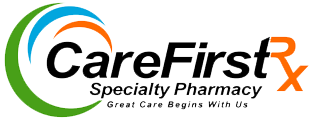Use of Guanfacine in Children with Autism
Use of Guanfacine in Children with Autism
By Casey Battersby
PharmD. Candidate 2020
August 2, 2019
CareFirst Specialty Pharmacy
What is Guanfacine?
Guanfacine is a selective alpha 2-adrenoreceptor agonist that reduces sympathetic nerve impulses to reduce a patient’s sympathetic outflow and subsequently cause a decrease in vasomotor tone and heart rate. Guanfacine is currently used for the management of hypertension, both alone and in combination with other agents, and for the management of attention-deficit/hyperactivity disorder (ADHD).
Guanfacine is available commercially as both an immediate release and extended-release tablet. From a safety perspective, guanfacine is reported to have a variety of adverse effects with the most common adverse effects being sedation, hypotension, dry mouth, dizziness, irritability, aggression, decreased appetite, headache, sleep disturbance, and constipation. The biggest safety concern with guanfacine is the potential of cardiovascular side effects. Because of this, guanfacine should not be discontinued abruptly to avoid causing increased heart rate and rebound hypertension and children on guanfacine should routinely have their blood pressure and heart rate is taken to adequately monitor for any negative side effects.
Guanfacine's Role in Autism Therapy
Guanfacine can also be used as an adjunct treatment in children with Autism Spectrum Disorder (ASD). ASD is defined as a biologically based neurodevelopmental disorder characterized by persistent deficits in social communication and social interaction and restricted, repetitive patterns of behavior, interests, and activities. Children with ASD are reported to demonstrate hyperactivity as well, both with or without the presence of an ADHD diagnosis.
Studies show that using guanfacine in children with ASD can help manage the symptoms of inattention, hyperactivity, and impulsivity. A multicenter randomized trial comparing extended-release guanfacine with placebo in 62 children with ASD observed the effect of the drug on hyperactivity, impulsiveness, and distractibility. The children who received guanfacine showed significant declines in the scores they received based on the ABC-hyperactivity subscale and showed higher rates of improvement on the Clinical Global Impression-Improvement scale. Another study found that when guanfacine was studied in children with ASD who had failed hyperactivity therapy with methylphenidate, almost 50% of the participants showed a significant response. However, it should be noted that in both studies, as well as a retrospective study of guanfacine use in children, reported a high incidence of sedation, constipation, irritability, and aggression while using this medication.
Does Guanfacine Have to be Compounded?
While guanfacine is commercially available as a tablet, it is important to note that this may not be a practical dosage form for children, especially for children with ASD who can have the added barriers of sensitivity to certain colors, smells, and flavors. By having a doctor write a prescription for a guanfacine compound, a compounding pharmacist is able to make the medication into a dosage form that is most suitable for the patient to be able to take the medication.
If you are looking to have guanfacine compounded, you can have your doctor send a prescription to CareFirst Specialty Pharmacy. For more information, you can visit www.cfspharmacy.pharmacy.
References
- World Health Organization. The ICD-10 Classification of Mental and Behavioural Disorders. Clinical descriptions and diagnostic guidelines. www.who.int/classifications/icd/en/bluebook.pdf
- Guanfacine. Lexicomp Online, Hudson, Ohio: Wolters Kluwer Clinical Drug Information, Inc.; 2019; August 8, 2019.
- Aman MG, Farmer CA, Hollway J, Arnold LE. Treatment of inattention, overactivity, and impulsiveness in autism spectrum disorders. Child Adolesc Psychiatr Clin N Am 2008; 17:713.
- Scahill L, McCracken JT, King BH, et al. Extended-Release Guanfacine for Hyperactivity in Children With Autism Spectrum Disorder. Am J Psychiatry 2015; 172:1197.
- Posey DJ, Puntney JI, Sasher TM, et al. Guanfacine treatment of hyperactivity and inattention in pervasive developmental disorders: a retrospective analysis of 80 cases. J Child Adolesc Psychopharmacol 2004; 14:233.
- Scahill L, Aman MG, McDougle CJ, et al. A prospective open trial of guanfacine in children with pervasive developmental disorders. J Child Adolesc Psychopharmacol 2006; 16:589.



Comments